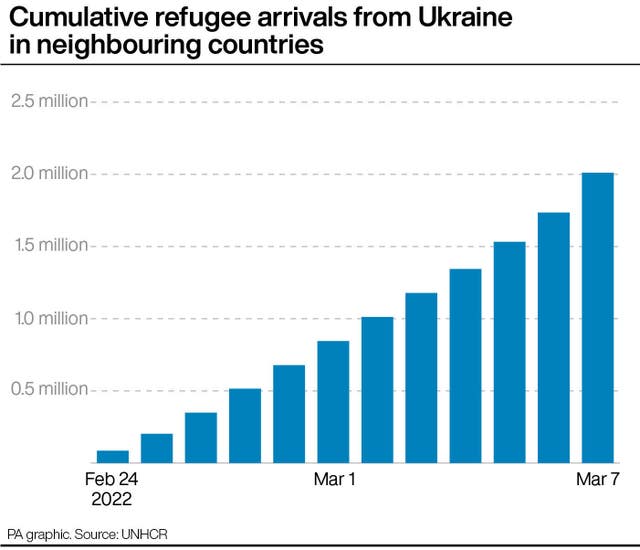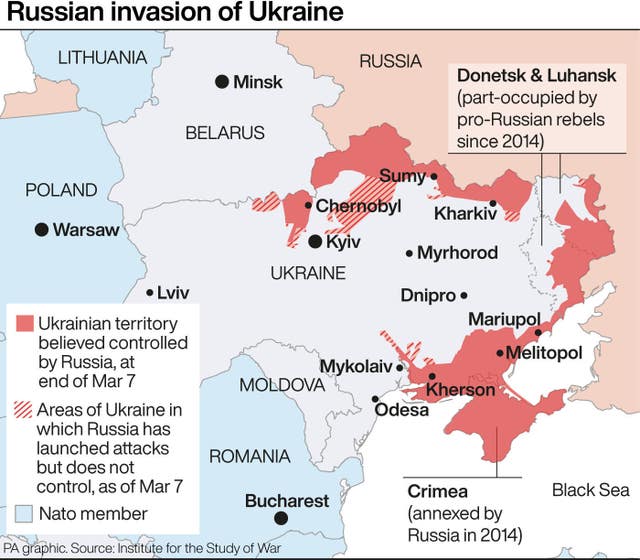
Ian Payne 4am - 7am
8 March 2022, 17:14

Europe’s worst refugee crisis since the Second World War grew even more severe.
Buses have carried civilians out of an embattled Ukrainian city along a safe corridor agreed by the warring sides, but a parallel effort to relieve the besieged port of Mariupol was thrown into jeopardy by reports of renewed Russian shelling.
Europe’s worst refugee crisis since the Second World War grew even more severe, with UN officials reporting that two million people have now fled Ukraine.
Moscow’s forces have laid siege to Ukrainian cities and cut off food, water, heat and medicine in a growing humanitarian disaster, but for days, attempts to create corridors to safely evacuate civilians have stumbled amid continuing fighting and objections to the proposed routes.

On Tuesday, a convoy of buses packed with people fleeing the fighting moved along a snowy road from Sumy, a north-eastern city of 250,000 people, according to video from the Ukrainian communications agency.
Deputy prime minister Iryna Vereshchuk said they were heading south west to the city of Poltava, and included students from India and China.
Hours before the convoy reached Sumy, overnight strikes killed 21 people there, including two children, Ukrainian authorities said.
Meanwhile, buses emblazoned with red cross symbols carried water, medicine and food towards the encircled southern port of Mariupol, scene of some of the worst desperation.

Ms Vereshchuk said the vehicles would ferry civilians out of the city of 430,000 people, but soon after officials announced the buses were on their way, Ukrainian authorities said they had learned of shelling on the escape route.
It was unclear whether the supply convoy made it to Mariupol, and it appeared unlikely that civilians would be able to board the buses to get out.
The deputy mayor of Mariupol cast doubt on the evacuations, telling the BBC that Russian forces continued to pound areas where people were trying to gather ahead of being taken out. He said some roads were blocked, while others were mined.

“So we cannot establish sustainable ceasefire and safety route at the moment,″ Serhiy Orlov said. “So we still have… a city in blockade.”
The city is without water, heat, working sewage systems or phone service. Residents have been getting water from streams or by melting snow.
Corpses lay in the streets and authorities planned to start digging mass graves.
With the electricity out, many people are relying on car radios for information, picking up news from stations broadcast from areas controlled by Russian forces or Russian-backed separatists.
In a video address from an undisclosed location, Ukrainian President Volodymyr Zelenskyy said a child had died of dehydration in Mariupol, another sign of the city’s desperation.
Nearly two weeks into the fighting, Russian forces have captured a stretch of southern and coastal Ukraine but have seen their advances stopped in many areas — including around Kyiv, the capital — by Ukrainian fighters targeting Moscow’s armoured columns.
Thousands of people are thought to have been killed – civilians and soldiers – although the actual number remains unknown.
The fighting has caused global economic turmoil, with energy prices surging worldwide and stocks plummeting. It also threatens the food supply of millions around the globe who rely on crops farmed in the Black Sea region.

Western countries have rushed weapons to Ukraine and moved to slap Vladimir Putin’s Russia with sanctions.
In a further effort to punish Russia, US President Joe Biden announced a ban on Russian oil imports, and Shell announced it will stop buying oil and gas from Russia.
Ukraine’s military said its forces continued defence operations in the Mariupol suburbs.
The military said “demoralised” Russian forces were looting, commandeering civilian buildings and setting up firing positions in populated areas.
The battle for Mariupol is crucial because its capture could allow Moscow to establish a land corridor to Crimea, which Russia seized from Ukraine in 2014.
Oleksiy Kuleba, governor of the Kyiv region, said Ukraine was also making arrangements to get people out of the suburb of Irpin.
Late on Tuesday, Mr Zelensky released a video showing him standing near the presidential offices in Kyiv. Behind him were piles of sandbags, a snow-dusted tree and a few cars.
It was the second video in 24 hours showing him near the country’s seat of power, apparently made to dispel any doubts about whether he had fled the city.
“Snow fell. It’s that kind of springtime,” he said in a soft voice. “You see, it’s that kind of wartime, that kind of springtime. Harsh. But we will win.”